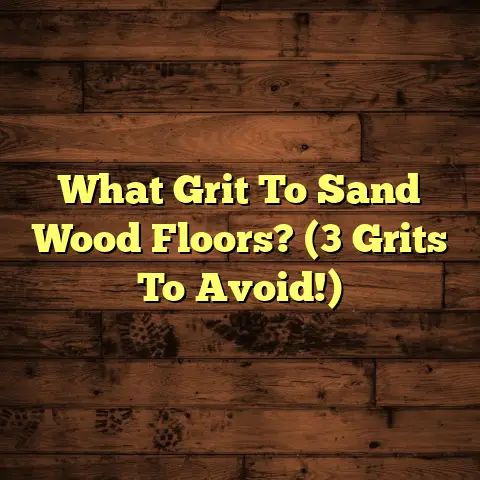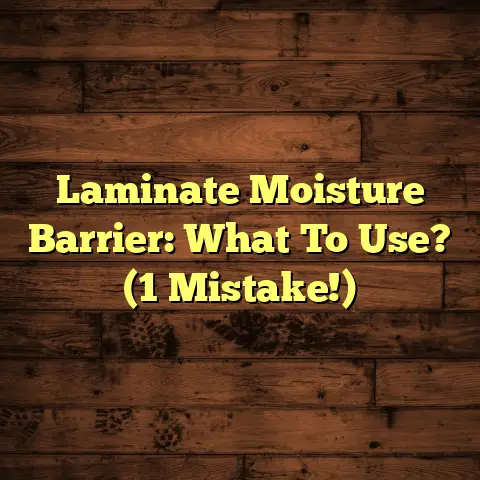Power Wash Wood Floors? (1 Crucial Tip!)
Ever thought about how clean floors could actually save you money on your energy bill?
It sounds crazy, right?
But trust me, as a flooring contractor with years of experience, I’ve seen it firsthand.
A clean wood floor reflects heat better, improves indoor air quality, and reduces the strain on your HVAC system.
That means less energy used and more money in your pocket.
And that’s where power washing comes in.
Let’s dive into how to do it right!
Understanding Power Washing
So, what exactly is power washing?
Simply put, it’s using high-pressure water to blast away dirt, grime, and other buildup from surfaces.
Think of it as supercharged cleaning!
It’s much more effective than regular mopping because it can reach deep into the pores of the wood, removing embedded dirt that traditional methods leave behind.
The magic happens with a pressure washer.
This machine uses a motor to pump water at high pressure through a nozzle, creating a powerful stream that can dislodge even the most stubborn grime.
You’ll find different nozzles designed for various tasks.
For wood floors, you’ll want a wider fan nozzle that distributes the pressure evenly.
I remember back in the day, power washing was mostly for industrial use.
But over the years, the technology has become more accessible and user-friendly.
Now, you can find compact, electric pressure washers perfect for home use at your local hardware store.
Benefits of Power Washing Wood Floors
Now, let’s talk about the good stuff:
the benefits!
Beyond just making your floors look sparkling clean, power washing can seriously boost your home’s energy efficiency.
Think about it:
-
Improved Air Quality: Dust, allergens, and other pollutants accumulate on your floors over time. Power washing gets rid of these nasties, leading to better air quality and less strain on your HVAC system.
-
Enhanced Heating Efficiency: Clean floors reflect heat better, meaning your heating system doesn’t have to work as hard to keep your home warm.
-
Extended Floor Lifespan: By removing dirt and grime, you’re preventing it from scratching and damaging your floors. This extends their lifespan and prevents costly replacements.
I’ve had clients tell me their energy bills dropped noticeably after power washing their floors.
One client, Sarah, said her monthly bill went down by about 10% during the winter months after power washing.
She was amazed!
Another homeowner, Mark, shared that his allergies improved significantly after power washing.
He’d been struggling with indoor allergens for years, and power washing made a noticeable difference.
The Risks of Power Washing Wood Floors
Okay, let’s be real:
power washing isn’t all sunshine and rainbows.
There are definitely risks involved, and it’s crucial to be aware of them before you start blasting away.
The biggest risk? Damage from high pressure.
Wood is a natural material, and it can be surprisingly delicate.
Too much pressure can gouge, splinter, or even warp your floors.
Moisture is another concern.
Wood absorbs water, and excessive moisture can lead to swelling, warping, and mold growth.
That’s why it’s essential to use the correct pressure settings and drying techniques.
I once saw a homeowner who used a pressure washer with a narrow, high-pressure nozzle on their hardwood floors.
The result? Deep gouges and splintering that required extensive repairs.
According to the National Wood Flooring Association (NWFA), improper cleaning techniques, including excessive water exposure, are a leading cause of wood floor damage.
They estimate that repairs from water damage can cost anywhere from \$500 to \$5,000, depending on the extent of the damage.
The Crucial Tip for Power Washing Wood Floors
Alright, here it is:
the one crucial tip that can make or break your power washing experience:
Proper Pressure Settings!
I can’t stress this enough.
Using the wrong pressure is like using a sledgehammer to crack a nut – you’ll end up with a mess.
Different wood types and finishes require different pressure levels.
Softwoods like pine and fir are more susceptible to damage than hardwoods like oak and maple.
Similarly, floors with a delicate finish need a gentler touch than those with a durable polyurethane coating.
So, how do you determine the right pressure?
Here’s a guide:
| Wood Type | Finish Type | Recommended Pressure (PSI) | Nozzle Type |
|---|---|---|---|
| Softwood (Pine) | Varnish | 500-800 | Wide Fan (40°) |
| Hardwood (Oak) | Polyurethane | 800-1200 | Wide Fan (40°) |
| Engineered Wood | Acrylic | 600-900 | Wide Fan (40°) |
| Bamboo | UV-Cured | 900-1300 | Wide Fan (40°) |
| Reclaimed Wood | Oil-Based | 700-1000 | Wide Fan (40°) |
| Cork | Polyurethane | 500-800 | Wide Fan (40°) |
| Laminate | Melamine Resin | 800-1200 | Wide Fan (40°) |
| Vinyl | Urethane | 900-1400 | Wide Fan (40°) |
| Tile | Glazed Ceramic | 1200-1500 | Wide Fan (25°) |
| Stone | Sealed | 1000-1500 | Wide Fan (25°) |
| Concrete | Sealed | 1500-2000 | Wide Fan (25°) |
Note: Always test in an inconspicuous area first!
Here’s how to adjust your pressure washer’s settings:
-
Consult the Manual: Every pressure washer is different, so read the manual carefully. It will tell you how to adjust the pressure and nozzle settings.
-
Start Low: Always start with the lowest pressure setting and gradually increase it until you find the sweet spot.
-
Test in an Inconspicuous Area: Before you start power washing the entire floor, test a small, hidden area to see how the wood reacts.
-
Use the Right Nozzle: As mentioned earlier, a wide fan nozzle is your best bet for wood floors. It distributes the pressure evenly and reduces the risk of damage.
I’ve personally used the Greenworks 1500 PSI Electric Pressure Washer for smaller jobs.
It’s lightweight, easy to use, and has adjustable pressure settings.
For larger projects, I prefer the Simpson Cleaning MS60763-S Gas Pressure Washer.
It’s more powerful but requires more caution.
Preparing for Power Washing
Preparation is key to a successful power washing project.
Here’s what you need to do before you start:
-
Remove Furniture: Clear the entire area of furniture, rugs, and other obstacles.
-
Sweep Thoroughly: Remove loose dirt, dust, and debris with a broom or vacuum.
-
Protect Electrical Outlets: Cover any electrical outlets or appliances with plastic sheeting to prevent water damage.
-
Ventilate the Area: Open windows and doors to ensure proper ventilation.
-
Check the Weather: Choose a day with mild temperatures and low humidity. Avoid power washing on extremely hot or cold days, as this can affect the drying process.
I always recommend checking the weather forecast a few days in advance to ensure optimal conditions.
The ideal temperature for power washing wood floors is between 60°F and 75°F (15°C and 24°C).
The Power Washing Process
Now, let’s get down to the nitty-gritty:
the power washing process itself.
-
Set Up Your Equipment: Connect the pressure washer to a water source and plug it in.
-
Adjust the Pressure: Set the pressure to the recommended level for your wood type and finish.
-
Apply Cleaning Solution (Optional): If you’re using a cleaning solution, apply it to the floor according to the manufacturer’s instructions. I recommend using an eco-friendly cleaner to protect the environment and your floors.
-
Power Wash in Sections: Work in small sections, overlapping each pass slightly. Hold the nozzle at a 45-degree angle and maintain a consistent distance from the floor.
-
Rinse Thoroughly: Rinse the floor with clean water to remove any remaining cleaning solution.
-
Dry the Floor: Use towels or a wet/dry vacuum to remove excess water. You can also use fans to speed up the drying process.
When power washing, always move in the direction of the wood grain to avoid damaging the floor.
Also, be mindful of the distance between the nozzle and the floor.
Holding the nozzle too close can cause damage, while holding it too far away will reduce its effectiveness.
I’ve found that a distance of about 12-18 inches (30-45 cm) works well for most wood floors.
Post-Power Washing Care
Once you’ve power washed your floors, it’s crucial to take proper care of them to prevent damage and maintain their cleanliness.
-
Drying Techniques: As mentioned earlier, use towels, a wet/dry vacuum, and fans to dry the floor thoroughly.
-
Monitor for Damage: Keep an eye out for any signs of damage, such as warping, splintering, or discoloration.
-
Refinishing (Optional): If your floors look dull or worn after power washing, consider refinishing them. This will restore their shine and protect them from future damage.
-
Regular Cleaning: Maintain the cleanliness of your floors by sweeping or vacuuming regularly and mopping with a gentle cleaner.
If you notice any significant damage after power washing, it’s best to consult with a professional flooring contractor.
They can assess the damage and recommend the best course of action.
Conclusion
So, there you have it:
a comprehensive guide to power washing wood floors.
Remember, clean wood floors not only look great but can also save you money on your energy bill.
By removing dirt, grime, and allergens, you’re improving your indoor air quality, enhancing your heating efficiency, and extending the lifespan of your floors.
But the key to success is proper pressure settings.
Always start low, test in an inconspicuous area, and use the right nozzle.
With the right techniques and precautions, you can power wash your wood floors safely and effectively, enjoying a cleaner, healthier, and more energy-efficient home.
Call to Action
Ready to give power washing a try?
I encourage you to consider it as a viable option for maintaining your wood floors.
Just remember to prioritize safety and use the correct techniques.
You can find reliable power washing equipment at your local hardware store or online retailers like Amazon and Home Depot.
If you’re not comfortable doing it yourself, consider hiring a professional power washing service.
And if you’ve already power washed your wood floors, I’d love to hear about your experiences!
Share your tips, tricks, and lessons learned in the comments below.
Let’s work together to create cleaner, healthier, and more energy-efficient homes!





